
MAY CONTAIN NUTS

Search Shorpy
SHORPY ART

Framed or unframed, desk size to sofa size, printed by us in Arizona and Alabama since 2007. Explore now.
Join and Share
Ad-Free Shorpy
Shorpy is funded by you. Patreon contributors get an ad-free experience.
Learn more.

Recent comments
- Pinstripes in the Tower
- Sound enhancement
- 3438 in '38
- Second Career
- Their days are numbered
- Only the Sensor
- Train control mechanism
- Rarest of the Rare?? & Classy 3400 Class
- Control Mechanism
- Those standpipes
- Wrenches
- International D-40 I believe
- Job prospects
- You had me at Train
- Land of the free
- Broad-Exchange Bldg
- Parking innovation
- The old block
- "Peck turned a sweet propeller"
- National Bank Building
- Notch shot
- Straight ahead (right, left, left, right)
- Ship lifespans
- New service
- You Say Station, I Say Potato ...
- Iron Age
- Thank you, Cornelius Vanderbilt
- Grand Central Terminal
- If they made a movie of it
- Obsolete by then.
Member Photos
The Shorpy
Printporium
Printporium
Search Shorpy
Search results -- 30 results per page
- By the Sea: 1915
- Circa 1915. "Surf bathing at Atlantic City." Where not all the suits are for swimming. 8x10 inch glass negative, ... shark" (that struck first at Beach Haven, just north of Atlantic City). Two wartime summers followed.
Towels "Towels" were ... Posted by Dave - 08/14/2012 - 4:28pm -
![By the Sea: 1915 Circa 1915. "Surf bathing at Atlantic City." Where not all the suits are for swimming. 8x10 inch glass negative, Detroit Publishing Co. View full size.
Lost horizonI like the sailing ship in the background.
On the Beach (apologies to Neville Shute) There's a lot going on here and it might be a record for Shorpy beach action photos: The light-haired person surrounded by captivated youths and holding forth about Sure-Wish-I-Knew-What, the apparently abandoned and (I hope) babyless carriage, the kid with the Buster Brown collar, the two casual wrestlers to the left of the Socrates Club, the Red Cross tent, the one overweight beach visitor (to the left of the wrestlers), the only person fully dressed in white asleep or dead in the right foreground, and so much more. The surf's up, and the horizon way off has a two-masted (I think) schooner heading north under full sail. Somebody get Gordon Lightfoot on the phone.
Beach tentShould we assume that the (red?) cross on the tent erected on the platform indicates that it's a refuge for the injured, ill, sunburnt, sun-stroked, or just down-with-a-case-of-the-vapors beachgoers? The sign posted reads "No Packages or Garments Permitted on or inside of railing." Because?
[Probably to keep the place from turning into a cabana. - Dave]
Outside!That's a decent little A-frame there, too. Nowadays there would be about a dozen surfers splitting that peak.
Possible eureka momentIs the person in white on the right side actually lying on a beach towel? Someone contact the patent office!
Surf's UpThe older guy is probably telling the young kids what surfing was like in the old days.
ScratchyI can feel the sand in my undies just looking at this photo!
ConversationsIn addition to Don Struke's comments, I just caught myself get all captivated thinking, "I wonder what they're saying to each other." Particularly the mustachioed man and his son (?) in the centre at the front. I wonder what they said when they turned away from the camera?
Wonderful shot, this.
Something else missingShorpy beach scenes have elicited lots of comments about the lack of beach towels, overweight people, etc. But here's something else that's missing: not a single person is holding a bottle, cup or drink of any kind. Nor are there any on the ground. Such a scene would be inconceivable today when nearly everyone walks around such places with a drink in hand.
For that matter, with the exception of a few parasols there are virtually no personal articles of any kind on the beach -- no satchels, no bags, no food, no toys. Just people and sand.
"Beach towels"The reason you don't see them isn't because the idea hadn't occurred to anyone. It's because big, body-size cotton towels, especially the terrycloth kind, were practically nonexistent in 1915. People bathed with washcloths and dried off with hand towels. Big towels didn't become a mass-market item until the 1930s. The alternative was woolen blankets, which you wouldn't take to the shore (or would be supplied by the hotels to their patrons) for obvious reasons. Also realize that doing any kind of laundry in 1915 was a major undertaking.
End of the innocenceAfter this season, things on the Jersey shore would never really be the same. 1916 brought a polio epidemic in New York City that send thousands fleeing the the city to the shore and other places, just in time for the arrival of the "man-eating shark" (that struck first at Beach Haven, just north of Atlantic City). Two wartime summers followed.
Towels"Towels" were linen or cotton, along the line of what we consider dishtowels (like those decorative souvenir dish towels). Just a tightly-woven sheet. Not particularly absorbent and not very big.
At the beach, a blanket would usually double as cover for changing in and out of costumes (if you didn't want to pay for the use of a bathing hut), keeping the wind off, and drying off at the end of the day.
(The Gallery, Atlantic City, DPC, Swimming)](https://www.shorpy.com/files/images/4a19460a.thumbnail.jpg)
- A Fast Crowd: 1905
- Atlantic City, New Jersey, circa 1905. "Rolling chairs on the Boardwalk." 8x10 inch dry ...
Rolling along Lots of things have changed in Atlantic City over the years, but on the boardwalk the rolling chairs are still ... Posted by Dave - 02/23/2014 - 12:24am -
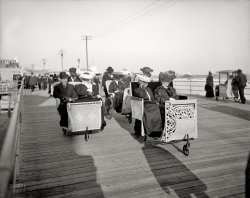
- Life-Savers: 1917
- The Jersey Shore circa 1917. "Life-saving lookout, Atlantic City, N.J." 8x10 inch dry plate glass negative, Detroit Publishing Company. ... Posted by Dave - 07/26/2012 - 1:44pm -
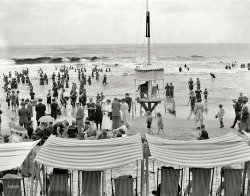
- A.C. Hotels: 1908
- Atlantic City, New Jersey, circa 1908. "Shelburne, Dennis and Marlborough-Blenheim ... to AC after wht it's become.
Rick
(The Gallery, Atlantic City, Swimming) ... Posted by Dave - 08/01/2022 - 12:00pm -
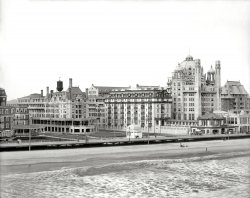
- Rock On: 1926
- ... Miss Washington, D.C., and a Miss America runner-up at Atlantic City in 1926. National Photo Company Collection glass negative. View full ... Posted by Dave - 07/27/2012 - 12:25pm -
![Rock On: 1926 August 2, 1926. "Miss Marjorie Joesting." Marjorie, the future Mrs. Arthur Lange, was both Miss Washington, D.C., and a Miss America runner-up at Atlantic City in 1926. National Photo Company Collection glass negative. View full size.
Gorgeous!Young Marjorie has a most beautiful smile and stunning hair.
A very pretty girl, in any era.
Bruce
Wow, talk about timelessWow, talk about timeless beauty, this one could step right into the 21st century and still stop traffic, look at those legs! Wonder if she's still alive? Guessing she'd be around 100, no?
[104. But they say 100 is the new 90. - Dave]
Today's GirlShe would be subject to severe dieting today to get her weight down to near emaciation or she wouldn't get near a spot in a major "Beauty" Contest.
AlterationsShe'd be compelled to get $8K implants today. To compete, anyway. In addition to losing about 40 pounds and 70 percent of that hair.
Excuse me....while I wipe the drool off my monitor... Wow...
Woo, WooIf I could go back in time and woo this woman, I'd give up every modern convenience we have today. She is striking!
Why she lostShe lost to Miss Tulsa by five votes. It was, according to the newspaper correspondent Peggy Ellsworth, "because she did not photograph as well as the Tulsa girl because she was too much of one color."
Five years later, the Lincoln (NE) Star caught up with her on a visit to relatives. The April 1931 story contains a great line: "Having sung over the radio and appeared on the stage, Miss Joesting has her eye on a combination of the two in the soon-to-come television broadcasting era."
Very classyShe is a beauty for sure. I like the fact that she is natural. I find myself wondering how "real" some of today's beauty queens are. Thanks for a great picture and a great site.
And the winner is .....
Miss America 1926
Norma Smallwood
Tulsa, Oklahoma
"photographing better than Miss Washington D.C. ?????"
Can you imagine?
Lotus Flower with the Sparkling Eyes I thank the photographer for capturing the lotus flower, Marjorie, for all grateful hearts! And I thank you, dear Charlotte, for introducing me to this great site!
(The Gallery, Natl Photo, Portraits, Pretty Girls)](https://www.shorpy.com/files/images/16115u_0.thumbnail.jpg)
- The Good Old Summertime: 1910
- Circa 1910. "Surf bathers at beach, possibly Atlantic City." Bathing-stockings optional! 8x10 inch glass negative, Detroit Publishing ... Posted by Dave - 04/27/2015 - 9:08am -
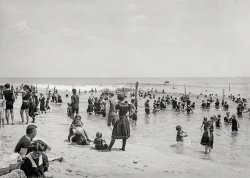
- A Sand Man: 1906
- The Jersey Shore circa 1906. "A sand man -- Atlantic City." The Michelangelo of sand sculpture. Detroit Publishing glass negative. ... Posted by Dave - 06/09/2018 - 4:40pm -
![A Sand Man: 1906 The Jersey Shore circa 1906. "A sand man -- Atlantic City." The Michelangelo of sand sculpture. Detroit Publishing glass negative. View full size.
Hey, it's a living!Interesting that the "I do this work for a living" message seems rather clumsily written in contrast to the exquisite sand carvings.
"I do this work for a living"In other words, stop gawking and throw some money in the hat!
No t-shirt or shorts in those days.No sir, he shows up to work in his tie and trousers albeit in shirtsleeves and sans bowler.
More like a GoyaThis may be the most depressing sand sculpture my eyes have seen, more akin to the work of Francisco Goya than Michelangelo. In the end, he's still a far better sand sculptor than myself for which drip castles are the limit of my capability.
Just asleepUnbelievable detail. And the material would have to be of just a certain consistency to be shaped as seen.
So why do we of an older generation never see these
sand based objects on our summer beaches?
[Like this one? - tterrace]
Who knew?I thought elaborate sand sculpture was a relatively recent phenomenon. Yeah, as recent as 106 years ago! Very talented man. I'm sure he snapped photos with his digital camera for his portfolio.
(The Gallery, Bizarre, Atlantic City, DPC, Swimming)](https://www.shorpy.com/files/images/SHORPY_4a27433a.thumbnail.jpg)
- Beach Baby: 1910
- The Jersey Shore circa 1910. "On the beach at Atlantic City." 8x10 inch dry plate glass negative, Detroit Publishing Company. View ... Posted by Dave - 08/21/2012 - 11:18am -
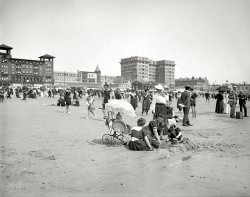
- Battleships vs. Broadway: 1910
- ... "Hudson River & Riverside Park; battleships of the Atlantic Fleet." Competing for our attention with a convoy of theater posters. ... association with the gayety of the promenade, or if the city adopts plans for the terminal arrangements of the promenade which would ... Posted by Dave - 07/28/2012 - 7:22pm -
![Battleships vs. Broadway: 1910 New York, October 1910. "Hudson River & Riverside Park; battleships of the Atlantic Fleet." Competing for our attention with a convoy of theater posters. Panorama made from two 8x10 inch glass negatives. View full size.
Grapes of WrathIs that Ma and Pa Joad's vehicle bottom left? They're lost!
So they loaded up the truck ...I'm pretty sure that's Jed Clampett's rig in the corner.
OMG!Someone give that baby a bottle!
The DesertersAfter doing some searches on Helen Ware and "The Deserters" I can't find any reference to the film anywhere. While Mrs. Ware's career is well documented, the film appears to have been lost to the ages.
[As noted in the title (and caption!) of this post, the signs are advertising plays, not movies. The Deserters gave 63 performances at the Hudson Theatre. - Dave]
Gotcha!"There is a photographer up there!"
"Rebecca of Sunnybrook Farm"I have heard that expressed in my family all my life. My parents weren't even born before 1918, so not sure why this little phrase or title was used. I suspect this play was popular at different times and not just in the early part of the 20th century.
I should have known it was a book. Looked it up on Ebay and there are several for sale. They have them from 1910 to 2003 printing dates.
[It's a famous children's book from 1903. The play came along later. - Dave]
Pleasant DayA lot going on here! We've got Riverside Park complete with some kids, Grant's Tomb, what seems to be an early version of New York's ubiquitous sidewalk construction awnings, and I believe that nice dome on the right is the beginning of the still unfinished St. John the Divine Cathedral.
Yet I'm more interested in the advertisements for the theatre; I wonder if Helen Ware was America's greatest emotional actress and if "The Deserters" ended up being the best musical drama since "Arizona."
Fleet's InPresident Taft reviewed the Atlantic Fleet in Boston in November 2010, before they left for Europe, so it makes sense they were assembled in the Northeast. Quite a few references can be found to an annual event called the Hudson-Fulton Celebration, which may be what is going on here. Ships present likely include the USS Delaware, USS Rhode Island, USS Virginia, USS Nebraska, USS Missouri, and USS Mississippi. One can see them on the Hudson in 1915 in this image (from here):
[I'm pretty sure Taft was not around in 2010. The Hudson-Fulton celebration was in 1909. In our 1910 photo, the fleet was in New York for a port call after target practice, and then overhaul in the various navy yards before returning to Hampton Roads in November. - Dave]
Sorry to be fat fingered. The ships left for Europe following the Hampton Roads assembly, and after leaving England they engaged in gunnery exercises off of Cuba before returning to Virginia in January. I see what you mean about the H-F being in 1909, yet several Navy sites suggest that there was an annual event along similar lines for several years before and after the 300th anniversary. Thank you for all the images - this is a great site.
[The Hudson-Fulton Celebration, held from Sept. 25 to Oct. 9, 1909, commemorated the 300th anniversary of Henry Hudson's discovery of the Hudson River and the 100th anniversary of Robert Fulton's steam engine. For more on the ships present, click here and here. - Dave]
Will they ever finish it?I took this photo a few years back. As you can see, they added much to the front of the Cathedral of St. John, and--a hundred years later--they are still working on it!
In the meantime, Columbia University has erected very uninspired buildings that all but obstruct the street view of the cathedral.
The steeple in the background is Riverside Church.
To us who live here and see this every day, the absence of the George Washington Bridge in the 1910 picture is most glaring.
"An infant is necessary"The partly-obscured poster with the scary infant advertises "Baby Mine," a farce by Margaret Mayo that opened in August 1910. I found this description:
"To retain her husband's affection, Zoie determines that an infant is necessary. She hates babies, but she does love her husband -- so, while he is away, she rents a couple of twins from an adjacent laundress, and the fun sets in!"
Riverside ChurchConstruction on Riverside Church didn't begin until the 1920s. If it were on the photo it would be just to the right of Grant's Tomb.
The tall building in the foreground is at 85th and Riverside Drive. Pretty much all the mansions along Riverside Drive were soon replaced with much larger apartment buildings.
Behind and to the left of St. John the Divine is St. Luke's hospital. The dome way in the background is a mystery to me. It must be where Columbia's east campus is located.
Milwaukee FamousHalf hidden among the theater signs is a billboard for Schlitz, "the beer that made Milwaukee famous". I remember that slogan and the logo were current 60 years after this photo. Apparently they weren't much for new campaigns.
St. John the UnfinishedYes, that is the Cathedral of "St. John the Unfinished." They found stone carvers in Italy a few years back who were able to carve stone in the same manner as the ones who most likely worked on the portion of the Cathedral seen here and finally completed the edifice a few years back, from what I understand.
Can you spot the Power Broker?There's a non-zero chance that one of the automobiles seen on Riverside Drive contains a young Robert Moses. This is where he got his formative idea of the parkway, which was for the weekend pleasure of the leisure classes. He would be riding in the back seat, naturally. As the century moved on and the automobile's role evolved from plaything of the rich to everyman's necessity, Moses never changed his views, and by the 1930s, he had the power at his disposal to see that his plans were carried out. Never mind that the motorist of 1931 or 2011 would be too busy negotiating traffic to enjoy the view! Driving was for the help! Robert Moses spent his career building highways, but never held a driver's license, and he lived to be 92.
Grant's Tomb (+13)
Washington Post, Aug 11, 1885
The Riverside Park Tomb.
The Views of Landscape Engineer Olmstead — The Actual Site of the Monument Not Determined.
New York, Aug 10. — Last week Frederick Law Olmstead, the landscape engineer, who was detailed to select a site for Gen. Grant's monument, wrote a letter to Park President Crimmins, in which he expressed the opinion that the site chosen for the Grant tomb and proposed monument in Riverside Park was not a suitable one. It would be extremely unfortunate, he thought, if the remains of the dead hero were brought into close association with the gayety of the promenade, or if the city adopts plans for the terminal arrangements of the promenade which would destroy its main character, or which will prevent the promenade from having the great northern view as its terminus.
The letter has caused a great deal of discussion, and Mr. Calvert Vaux, the landscape gardener of the Central Park has replied to it at length. He says that there is nothring in the most of Mr. Olmstead's objections. He favors erecting the monument and final tomb on the southern portion of what is called "the loop," and then it would be practically out of the park with a public road all around it. Small pathways leading to it for foot passengers could also be made and the view from the drive and park would be in no way impaired.
Mayor Grace said today: The actual site for the monument, or what sort of a monument it will be, has not yet been decided upon. I do not think a better site could possibly have been chosen than the one near the temporary tomb, and there is plenty of room there for a very large monument without in the least obstructing the view or in any way destroying the beauty of the spot. I shall certainly take no action in the premises. The whole matter will be referred to Mr. Vaux and Superintendent Parsons, and they will report to the park commissioners as to the best site for the proposed monument.
It was said at the office of the park commissioners to-day that the plan of laying out the northern part of Riverside Park had been modified to correspond to a great extent with the views of Mr. Olmstead. At first it was intended to have the permanent monument at a point about two hundred feet north of the tomb, but it will not be placed directly back of and near the tomb.
The Claremont House will remain and the handsome bluff will be reserved for those who visit it for recreation. From One Hundred and Twenty-first street to One Hundred and Twenty-fifth street in the park will be set apart exclusively for the burial ground of Gen. Grant, and a roadway will be laid out north and south of the tomb on a line with One Hundred and Twenty-fifth street, so as to separate the burial ground from the other portions of the park.
The park commissioners have determined to secure the land lying east of Riverside Park, extending to Claremont avenue to one side and One Hundred and Twenty-second street to One Hundred and Twenty-fifth street on the other. As soon as the park commissioners have secured a title to these grounds in the vicinity of the tomb, and thus the necessary quiet will be secured to the spot in which the General's remains are deposited.
The key of the vault is kept in the large safe in the park commissioner's office.
To your left, Grant's TombHow about that double-deck bus down in the lower left? A dated version of the current crop of open air vehicles that are seen all over Manhattan, even on rainy days.
Beautiful!As someone who gets off the subway a stop early just so I can walk up Riverside Park, I thank you for the picture. The buildings may change, but the joy of a stroll through the park remains the same.
Mr PumpkinheadIt's probably a fancy dressed lady in a big hat, but from this angle doesn't the person on the path, at the bottom of the picture, look like Mr. Pumpkinhead with a long coat?
(Panoramas, Boats & Bridges, DPC, NYC)](https://www.shorpy.com/files/images/Riverside_Panorama1.thumbnail.jpg)
- The Teeming Shore: 1910
- ... our theme of waterfront scenes with stripes. "Bathing at Atlantic City." 8x10 inch dry plate glass negative, Detroit Publishing Company. View ... Posted by Dave - 08/21/2012 - 10:51am -
![The Teeming Shore: 1910 The Jersey Shore circa 1910, continuing our theme of waterfront scenes with stripes. "Bathing at Atlantic City." 8x10 inch dry plate glass negative, Detroit Publishing Company. View full size or fast-forward a few years.
"Oh the agony of de-feet"The few times I ventured to AC my wife loved the beach, I the casinos, I couldn't stand the hot sands and I can't believe back then that things were not as hot! Where is the agony of the face that I had?
Too much skin!Muscle shirts, shorts way above the knee, oh my!
Some of those gentlemen are on the verge of being immodest!
Canine SightingAt the bow of the boat upper middle of the picture. Looks like it even has a collar of some kind. The dog looks just like a rescue dog that was our family pet several years ago.
Where are all the towels?Something that always strikes me about these old beach scenes is the severe lack of towels and/or blankets. This shot today would have more towels than beachgoers! I can find evidence of only one blanket in this whole photo - a woman is sitting on one to the left of the walkway just before the hanging chairs. Was washing a sandy towel at that time too onerous to consider bringing them to the beach? Many of the boys are far sandier than I think you'd see at the beach today.
[When this picture was made, there were no towels to bring. At least not what we would think of as a beach or bath towel. Big terrycloth or cotton towels were not a mass-market item in 1910, and laundry was a labor-intensive chore. - Dave]
Now that Spring is NearI can't wait to don my coat and tie, grab my hat and head to the beach for some refreshing salt air.
FlaggedNice set of flags being displayed on the shore side of the first aid tent. On the right is the good old Stars and Stripes, the 1908-1912 46-star version. In the middle is the relatively new flag of New Jersey (adopted 1898). On the left is a display of the US Weather Service's 1887 style forecast flags, a white-over-blue square over a black pennant. The flag indicates local rain (or snow) is forecast within 24 hours while the pennant below indicates the temperature will drop (if it had been above it would have meant a temperature rise). It is interesting to note that back in the pre-radio days many people could read these types of flags with ease; a number of different pamphlets were distributed showing the flag combinations.
Itchy and ScratchyIt must have taken DAYS to get the sand out of their britches.
Same place, same year. Same man?The man on the right of this picture looks very much like this one from the photo "Hands up in Atlantic City 1910" What do you think? Could be the same man?
(The Gallery, Atlantic City, DPC, Swimming)](https://www.shorpy.com/files/images/4a18708a.thumbnail.jpg)
- The Tickler: 1909
- ... isn't appropriate in public mixed company.
The Atlantic City theme continues, with boxes of its famed salt water taffy proudly offered! ... Posted by Dave - 07/29/2012 - 2:41pm -
![The Tickler: 1909 Cincinnati circa 1909. "Chester Park -- the Tickler." Now "not as rough." 8x10 inch dry plate glass negative, Detroit Publishing Company. View full size.
The lady's not for TickleringOnly young men seem to enjoy it. The women standing below are gazing at it dubiously - as I would too. For one thing, their hats are a lot more difficult to put on and take off. For another, the excitement the ride induces probably isn't appropriate in public mixed company.
The Atlantic City theme continues, with boxes of its famed salt water taffy proudly offered! You may have had to leave your idylls of the Jersey shore, but taffy's teeth-pulling sweetness is still available to remind you of the salt spray, even after you're back in Ohio.
What goes downI'm sure that even with the remodeled Tickler, many still lost their popular price luncheon!
By the late 1920sI think is when they closed Chester Park. Coney Island and the new Riverdowns horse track took over by the 1930s. I always thought Coney Island was Cincinnati's first amusement park until I saw this site. The current location now holds a Honda dealership and a Kroger grocery store.
Tickler on the West CoastThe Tickler could also be found at the 1909 Alaska Yukon Pacific Exposition held in Seattle. The fabulous documentary "The Alaska Yukon Pacific Exposition: Seattle's Forgotten World's Fair" has footage of the Fairy Gorge Tickler in action beginning at 24:27:
http://www.seattlechannel.org/videos/video.asp?ID=4030901
Another good image of the ride in question being used is here:
http://www.flickr.com/photos/uw_digital_images/3383228748/
You can tell just how popular it was by the line of people waiting to get on! Evidently the thrill was worth the whiplash.
My aching neck!Claims to be not as rough, but I hurt just looking at it!
Also known asThe Kidney Stone Crusher!
Rubber bumpersThe secret to the ride is the rubber bumpers. The bumpered car rolls along against the railings, carrying it down the slanted floor. The cars would spin along the track as they descended.
Tickler historyThe idea of a ride named ticker has apparently been around for a while.
The Tickler name holds special significance in the history of amusement rides and of Coney Island. The Tickler was the first amusement ride "designed to jostle, jolt and jounce its riders about in their seats when the ride was in motion," according to its inventor and manufacturer William F. Mangels.
More here.
Human pinballIt's interesting to see there are reflectors mounted on the arc lamps in this photo.
"Not as rough as last season"Those six words make my imagination go wild. Just how bad was it last season that they feel compelled to mention it?
New and ImprovedIt shouldn't kill nearly as many people this year!
"Not as rough"Quite a bit more popular than its predecessor, "The Lacerator."
The Hat ExchangeThere is a sign that reads "HATS" and some lined circular containers nearby. I guess if you were afraid that your hat might blow away during your Tickler experience you left it in one of those receptacles. If there were enough of them in the bin I wonder if someone looking for an upgrade just helped themselves and left you theirs.
[The "lined circular containers" are what you ride in. The hat basket is what the sign is attached to. - Dave]
FrazzleI want to know what's inside "Frazzle."
RemodeledAny truth to the rumor the work was done by a French company?
"Mangels"The inventor was a man named Mangels? Ah. Last season must have been a hoot and a half.
The First VariationThis must have been the predecessor of The Price Is Right's Plinko game on a slightly larger scale. Frankly, I've love to see it in motion. Amusement park rides of yesteryear had so much more charm than the overly padded and seat strapped and belted rides of today. There is something to be said for the thrills one gets from riding and surviving intact a hair raising ride such as this. Today's rides may be higher and faster but they lack the genuine fear factor and adrenaline rush that real danger provides.
I can only imagine the concessions possible on the "I survived the Tickler" wool t-shirts, wool neckties, and wool bathing suits.
Instant InjuryJust don't let your arms hang too far down on the outside, or your fingers will get squished into useless tentacles.
HeadwaiterThe bloke wearing the dark suit looks like the headwaiter in a mortuary. Maybe he is waiting to pick up customers that didn't survive the ride.
[I don't even want to ask what kind of mortuary employs waiters! - Dave]
Instant injury (2)And be careful how your tentacles are hanging as well!!
How does it move side to side?Since the cars don't appear to have any motors and the planks have no rails to guide the cars, I wonder how they move thru the railings left to right/right to left? Gravity wouldn't move the car sideways, only down.
[The rotation of the car might be enough to move it from side to side. Or the railings might be angled down a bit. Or both. - Dave]
MisnomerHow would this "ride" do anything but rattle you to the core?
Tilt-a-whirlThis looks like an early albeit extremely-dangerous looking tilt-a-whirl from amusement parks of today.
Oddly, there doesn't look to be any sort of stopper mechanism at the end (or padding)... hopefully it didn't go too fast.
The sign at the top is amazingI'd love to get a large image just of the sign at the top. The decoration on the lintel is also great.
(The Gallery, Cincinnati Photos, DPC, Sports)](https://www.shorpy.com/files/images/4a19361a.thumbnail.jpg)
- Schlitz Hotel: 1910
- Circa 1910. "Schlitz Hotel, Atlantic City." On the Boardwalk at Ocean Avenue. 8x10 inch dry plate glass negative, ... that showcased their products. Also, these hotels were in Atlantic City, a long way from Milwaukee, and that beer didn't travel that well ... Posted by Dave - 10/14/2016 - 9:47pm -
![Schlitz Hotel: 1910 Circa 1910. "Schlitz Hotel, Atlantic City." On the Boardwalk at Ocean Avenue. 8x10 inch dry plate glass negative, Detroit Publishing Company. View full size.
Beer Hotels?I see that the Schlitz Hotel has the same logo as the brewery and next door (to our left) is the Blatz Hotel. That was (is?) another brewery from back in the day. Did these breweries own lodgings? I know that they did run restaurants that showcased their products. Also, these hotels were in Atlantic City, a long way from Milwaukee, and that beer didn't travel that well in those days, was there a locally-owned brewery?
[The sign next door is for Blatt Royal, a haberdashery. - tterrace]
Lovely Stained GlassSuch interesting buildings. I love the designs and visual interest each have. The details, such as the stained glass awning at the Schlitz entrance and the transom on the other hotel. I bet they were gorgeous when backlit in the late evening or night. Also the turret corner is lovely. The Bank is my favorite with all the beautiful ironwork. Too bad we don't have such interesting and pretty details on buildings today. Instead most of what we have today is a square, bland Lego block style. IMHO they are depressing to look at.
(The Gallery, Atlantic City, DPC)](https://www.shorpy.com/files/images/SHORPY-4a24009a.thumbnail.jpg)
- The Wild, Wild East: 1911
- Atlantic City, New Jersey, circa 1911. "Savoy Theatre, Schlitz & Young's hotels." ... Thompson looking out the hotel window?
(The Gallery, Atlantic City, DPC, Horses, Swimming) ... Posted by Dave - 08/24/2011 - 1:23pm -
![The Wild, Wild East: 1911 Atlantic City, New Jersey, circa 1911. "Savoy Theatre, Schlitz & Young's hotels." 8x10 inch dry plate glass negative, Detroit Publishing Company. View full size.
Re: I'm Freaked OutOh, good. I saw too many '50's sci-fi flicks without my mom's permission
and she always warned me they'd warp my brain.
Best-dressedI must say, the young woman all decked out in classic riding habit at the center is stylin' indeed. Complete with riding crop*, useful should that chap get fresh.
*You can easily make out the handle in her hand, but as she's swinging it slightly, the rest is blurred and blends in with the folds of her skirt.
I'm freaked outWhat the devil IS this?
[Two saddles. - Dave]
For the fairer sex Ladies' side-saddles to be exact.
On the sideNeat! I'm a side saddle rider and I always scan any photo with horses for a glimpse of side saddles or ladies riding aside. Cool to see a side saddle in its original time.
The lady is most likely holding a "hunt whip," which is different from a crop. Hunt whips have an L-shaped handle, usually made of antler, which is handy for hooking onto gates to open them without dismounting. The lash of the hunt whip is used to control the hounds on a hunt.
Weird that the two side saddles that freaked out Rip seem to be "for hire." Riding side saddle is not something you can just hop and and do without some training.
Boardwalk EmpireIs that Nucky Thompson looking out the hotel window?
(The Gallery, Atlantic City, DPC, Horses, Swimming)](https://www.shorpy.com/files/images/4a25632a.thumbnail.jpg)
- The Chalfonte: 1913
- Atlantic City, New Jersey, circa 1913. "Chalfonte Hotel." 8x10 inch dry plate glass ... say?
Must be a disposable. I've lived near the Atlantic my whole life and I'm not sure I've ever seen anybody canoeing it.
... Posted by Dave - 08/14/2012 - 12:54pm -
![The Chalfonte: 1913 Atlantic City, New Jersey, circa 1913. "Chalfonte Hotel." 8x10 inch dry plate glass negative, Detroit Publishing Company. View full size.
Duntley PneumaticThere are the ubiquitous Salt Water Taffy, and the familiar Welch's Grape Juice, but I had to look up the Duntley Pneumatic Cleaner.
This thing makes the old Kirby Classic we had look like a featherweight!
Today's beachwearA couple of days ago, I saw several topless women sunbathing on Miami Beach. Topless women is a common sight on the beach there. I am curious what the people in this 1913 beach scene would think about what I saw on Miami Beach and I did not give it a second thought.
Pregnant woman at the beach.There appears to be a young woman "in a family way" standing at the edge of the surf with her hands behind her back. I do not recall seeing another expecting mother in a beach crowd from Shorpy's turn of the century archives.
[That's a man, and probably not preggers. - Dave]
Corsets optionalAll over the world "clothing optional" beaches are gaining in popularity and people are willing to put it all out there in little or nothing. I marvel at the huge quantity of clothing most of these people wore to the beach including hats, coats, jackets, umbrellas, boots, belts, corsets, etc. and here we are one hundred years later wondering "what were they thinking?" If they could come back and judge us in speedos and thongs, what do you think they would say?
Must be a disposable.I've lived near the Atlantic my whole life and I'm not sure I've ever seen anybody canoeing it.
Corsets, etc.If they could come back and judge us in speedos and thongs, what do you think they would say?
I suspect they would envy us our lack of scratchy and heavy bathing wear, as well appreciate the invention of sunblock, flip flops and beach towels.
ChalfonteHuh -- my family is from Chalfont, Pennsylvania.
I had a friend years ago who said it sounded like one of those diseases people don't catch anymore.
Pre-CoppertoneThe clothing in these old beach pics reminds us that a deep tan was not always cool. At the turn of the century only common laborers had a tan, and true ladies and gentlemen avoided said tan at all cost. Of course I'm not telling you Shorpters anything you don't already know. That's why you're Shorpsters.
Aunt KateMy great-aunt Kate Devon worked at the Chalfonte in the very early 1900s as a maid. Later as a manager of the linen closet operation. She also did calligraphy for fancy weddings and dinners that were held there. She apparently made good wages or otherwise got tips or other favors, as she vacationed in Florida during the winter.
WaxworksMy mom took my sisters and myself to the Chalfonte in August 1971. It was still very elegant but one got the sense that time had already passed the place by. My strongest memory is one of the old matrons that spent her summer at the Chalfonte expressing her displeasure that my mom was taking us kids out to the amusements after 8 pm!
(The Gallery, Atlantic City, DPC, Swimming)](https://www.shorpy.com/files/images/4a19467a.thumbnail.jpg)
- Human Roulette: 1908
- The Jersey Shore circa 1908. "Atlantic City bathing beach and Steeplechase Pier." Who out there can fill us in on ... by the defendant company upon the Steeplechase Pier in Atlantic City. The Steeplechase Pier is an amusement resort upon which is ... Posted by Dave - 06/25/2014 - 8:16pm -
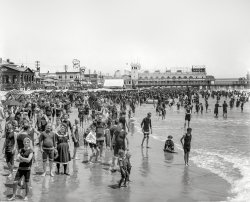
- Big Boumi: 1923
- ... built by Baldwin in 1916.
The little engine is the Atlantic, but it really isn't the Atlantic. The original Atlantic was built in ... at Mt. Clare until the 1880s to pull cars through the city. The original "Pioneer" was scrapped at an unknown date. A replica was ... Posted by Dave - 05/20/2014 - 7:30am -
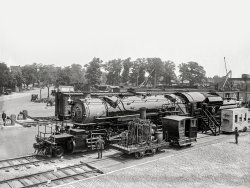
- The Human Tide: 1908
- Atlantic City circa 1908. "Bathing beach and Steeplechase Pier." With signs advertising ... day The old girl always photographed beautifully. The Atlantic City pictures are some of the most interesting to appear on this site. ... Posted by Dave - 06/18/2016 - 1:06pm -
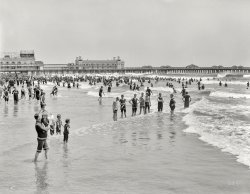
- Potomac Yard: 1925
- ... Yard, Stadium, Airport My former office in Crystal City overlooks the remaining RR yards between CC and National Airport. (not ...
- Southern Railway
- Chesapeake and Ohio Railway
- Atlantic Coast Line Railroad, and
- Seaboard Air Line Railway
Potomac ... Posted by Dave - 09/04/2012 - 4:00pm -
![Potomac Yard: 1925 Circa 1925. "Potomac Yards, Alexandria." The railyard just outside Washington in Alexandria, Virginia. National Photo Company glass negative. View full size.
Trackless VoidThe entire Potomac Yard area is now just big box retailers, chain restaurants and hotels. What's left of the RF&P is just a real estate company.
Hump YardWhen I was a Boy Scout in the early 1960s we took a tour of Potomac Yards, including a trip to the two-story brick "control tower" in the backbround. Freight cars were pushed by a switcher engine to the top of the hump (a gentle hill) and then cut loose and rolled downhill by gravity, shunted to their particular assembling track by the levers in the control tower. This tower housed all the switches for the entire yard. There were also external air brakes on the side of the rails that could be remotely actuated from the tower to control the speed of the cars.
The employees had to park along Route 1 on the left of the picture and take the pedestrian bridge (seen in the background) over the main line to the control tower.
Click the map to enlarge.
W&OD FlyoverThe Washington & Old Dominion RR had a flyover track across Pot Yard here that connected with the Southern Ry. a little farther to the SE of where I think this photo was taken.
View Larger Map
My Dad's RailroadMy dad worked at Potomac Yard as a train engineer from the very day he returned from World War II in early 1946 until the very day he retired in 1990. Then saw entire company disappear virtually overnight when the Richmond, Potomac & Fredericksburg line realized the land the yard was on was far more commercially viable than any railroad. The Washington Redskins were going to build their new stadium there and a ground breaking took place. Local residents fought to have the football stadium put elsewhere. They won. And Potomac Yard is now a shopping center with mixed-use residential being now added.
How strange to see Route 1 on the left side of this photo a small, quaint two-way street. Today it bustles with traffic. And although the railroad still moves people and freight along the corridor, the tracks were moved to the the east, next to Metro's above-ground tracks.
Growing up, I spent many hours in Potomac Yard playing on the engines with my father.
Potomac Yard, Stadium, AirportMy former office in Crystal City overlooks the remaining RR yards between CC and National Airport. (not everyone calls it by the current name)
Yes, there was a protest about the stadium being located at the yards, but the real backstory is that Jack Kent Cooke, Redskins owner, played VA, MD and DC like a set of violins until he got was he wanted. The protests were not really a factor in the final decision; Cooke's marionette show did the trick.
Potomac Yard from aboveThis aerial view from 1975 shows the tower at Hume Street and the man bridge at x East Glebe Road. The W&OD flyover shows at Randolph Street. Until the early 1980s, maybe later, there was a restaurant across Route 1 (locals called it Number 1 or Number 1 Highway), called Steve's, open 24/7 for the Yard workers. Would stop for breakfast on the way home from Georgetown.
Re: Dad's RailroadHi: I noticed you edited my comments about My Dad's Railroad. That's fine--I appreciate you posting my remembrances, but your inference (re-write) that "RFK Stadium's owners realized the yard was far more commercially viable than any railroad" is absolutely incorrect. RF & P Railroad OWNED THE LAND--not The DC or Federal Government. ...
[Back up a little. Your original comment did not say "RF&P's owners." It said "RFK's owners." - Dave]
My Granddad's RailroadMy grandfather was a brakeman on the Southern Railroad in 1925 on the Spencer, N.C., to Washington run. My question is: Was Potomac Yard used for Southern RR traffic, or was it only for the Richmond, Potomac & Fredericksburg Line?
Users of Potomac YardRailways using Potomac Yard included:
- Pennsylvania Railroad
- Baltimore and Ohio Railroad
- Southern Railway
- Chesapeake and Ohio Railway
- Atlantic Coast Line Railroad, and
- Seaboard Air Line Railway
Potomac Yard in Wikipedia.
Our GrandfathersI can't help but wonder if our grandfathers knew each other. My grandfather was a career RR worker and worked at Potomac Yard, transferred to Spencer NC, on to Monroe VA, and then back to Potomac Yard. His career span included 1925.
To answer your question, yes.
Where there's smokeThe smoky sky in this and many Shorpy photos is a reminder that not everything about the good old days was so good.
Rails run deepI'm sure they probably did cross paths at some point. My grandfather (known as "Pa" to us grandchildren) was a brakeman, flagman, and conductor on the Southern from 1908-1950. He lived in Spencer but worked "on the road" for several days a week between Spencer, Monroe, and Washington for 42 years straight. It was hard but honest work. He is sorely missed.
When we sat down to dinner, as only a true brakeman would say, instead of asking "Pass the biscuits" he would routinely say "Knock the brakes off the biscuits, please"!!
Thanks, Dave for showing us a glimpse of the past.
Southern's use of Potomac YardSouthern was one of six railroads that managed the yard and its operations. Except during a period in the 1920s when Southern felt the RF&P, which basically managed the yard and its switching, was getting a little too cozy with at least SAL and ACL, giving them preference. At least that was the allegation. Southern then built the Cameron Street yard, which still exists as an intermodal yard for transferring I think LPG. When Southern built this yard, it apparently also enticed the C&O to join, and then the fit hit the shan, so to speak. The Pennsy, which was a co-owner in the yard operations like the other RR's, sued Southern charging breach of contract and other things, and after a year or two of squabbling, all became peaceful again and Southern rejoined switching in Potomac Yard, although it also maintained its own yard just south of Duke Street, which is totally unrecognizable today as a redeveloped region known as Carlyle. This yard had it origins in the 1850's and the beginnings of railroading in the region with the Orange & Alexandria. Supposedly, the reason for the Cameron yard's location was because that was the vicinity of where the never completed Manassas Gap Independent Line was to cross the Orange & Alexandria in the 1850's. Title to the lands passed to descendants of the O&A, which became Southern in 1894.
This may not be 100% of what happened but I have reason to believe it is the basic idea, if you get my drift.
A Local Historian
Monroe to SpencerSince a couple of comments mention the railroad run from Monroe, Va., to Spencer, N.C., you might like to know that this is the run that is the basis of the folk/bluegrass song "The Wreck of Ole 97," made famous by Flatt & Scruggs.
White polesWhy are the utility poles are painted white at the bottom?
WhitewashThe whitewashed pole bases were for night visibility. Normally, the lower 6-8 feet of all buildings + poles, especially in the roundhouse area, were whitewashed, including the inside walls of the turntable pit. Incandescent lighting was pretty dim in railroad yards back then, and the whitewash really made a safety difference.
Where?"Southern rejoined switching in Potomac Yard, although it also maintained its own yard just south of Duke Street, which is totally unrecognizable today as a redeveloped region known as Carlyle"
I work at the Patent Office on Dulany St. Where was this yard, exactly?
Wes Clark
wes.clark@uspto.gov
Potomac YardsMy father also worked at Potomac Yards, from 1924 to 1963. He was a machinist at the round house. We lived not far from the yards in the Del-Ray section. (DeWitt Ave)
For Wes Clark who works on Dulany Street, that street of course did not exist before the Carlyle project. The Southern yard was right about where your desk sits now. There was a small round house and several tracks. There was also at one time a small building housing a club that had an extensive model rail display.
George "Walt" Gray
Retired fire captain.
Haz-Mat Officer
Station Captain #2 Station, Windsor Ave.
Alexandria VA.
RR ClubThe RR club was in the Southern Railway yard behind Herby's Ford on Duke Street, not Potomac Yard. They were there until the early 70's.
Seen in the background here.
Re: RR ClubThat's what I said: "The Southern yard was right about where your desk sits now. There was a small round house and several tracks. There was also at one time a small building housing a club that had an extensive model rail display"
Just happened by this site.Just happened by this site. I wonder if my grandfathers knew yours. Both of mine were also career Southern RR men out of Monroe, Va, two uncles worked for Southern in Alexandria, and 2nd cousin was a conductor with Southern also out of Monroe. Had a great grandfather that also worked on the Southern RR in Monroe too! Small world!
RF&PMy father, Granville A. "Granny" Corr, Jr. worked for the RF&P for over 40 years. Wasn't it referred to as the "richest and smallest" railroad in the country?
(The Gallery, Natl Photo, Railroads)](https://www.shorpy.com/files/images/32905u_0.thumbnail.jpg)
- Steeplechase Pier: 1905
- The Jersey Shore circa 1905. "Steeplechase Pier, Atlantic City." Appearing April 22: The Mask and Wig Club of U-Penn performing "Mr. ... Posted by Dave - 08/13/2012 - 10:20pm -
![Steeplechase Pier: 1905 The Jersey Shore circa 1905. "Steeplechase Pier, Atlantic City." Appearing April 22: The Mask and Wig Club of U-Penn performing "Mr. Hamlet of Denmark." 8x10 inch dry plate glass negative, Detroit Publishing Company. View full size.
I wonder... what time of year this is? No one is on the beach or the pier.
[It's April. - Dave]
Shills rolling chairsWhy yes. I believe he is.
Gone, gone, all gone nowToday most of the traffic on the boardwalk is people shuffling from one gambling casino to the next. There are few attractions. The benches are mostly occupied by the homeless, who tend to be dirty and talk loudly to themselves. Instead of sun and the sounds of the surf, what most people experience these days is the constant din of endless rows of slot machines inside cavernous, windowless rooms. It's hard not to sound negative, AC really is bleak.
Got Windex ?Imagine the chore it must have been to keep those beautiful ornate windows clean. Salt spray had to be the worst culprit.
I was wondering.Quevic?
After this Steeplechase Pier Burnt DownI worked on the replacement Steeplechasr from 1944 to 1948, I ran the Ferris Wheel and my best friend Felix ran the Dodgem cars. This was B.C. -- before casinos. A great place to grow up in.....Lew Bobb
(The Gallery, Atlantic City, DPC, Swimming)](https://www.shorpy.com/files/images/4a12632a.thumbnail.jpg)
- Another "Bathing Beauties" Image!
- ... wool bathing suits were to wear on the sunny beach at Atlantic City. Note: I "assume" this is Atlantic City. Does anybody have any ... Posted by dougramsey - 07/09/2007 - 3:32am -
![Another "Bathing Beauties" Image! Here is another image from the album I purchased. I can only imagine how itchy and hot their wool bathing suits were to wear on the sunny beach at Atlantic City. Note: I "assume" this is Atlantic City. Does anybody have any information regarding the "Globe" (theatre?) sign in the back ground to substantiate this being Atlantic City?
Globe TheatreThere was apparently a Globe Theatre in Atlantic City:
http://cinematreasures.org/theater/17056/
and
http://scriptorium.lib.duke.edu/eaa/maxwell/M03/M0357-72dpi.jpeg
(also linked to by the above article) looks like it could be a later picture of the same area of the Boardwalk.
BTW, the people-powered "taxis" (I don't recall what they were called - "jitneys" I think) in the 1922 photo were still in use into the 1960s, I remember seeing them as a child.
Globe TheatreWhen I was growing up in Ventnor, (next to Atlantic City) in the fifties, the Globe was notorious as a burlesque theatre. My friends and I would never dream of trying to go in, but we gasped at some of the racy pictures posted outside. Today, they'd be considered mild, I guess.
As for "jitneys," the word refers to the small-capacity (about 12 passengers) busses that run on Pacific Avenue only and only in Atlantic City, not downbeach to the rest of Absecon Island.
[The jitneys mentioned below were not buses. - Dave]
(ShorpyBlog, Member Gallery)](https://www.shorpy.com/files/images/coney_island_beauties.thumbnail.jpg)
- Pier Pressure: 1905
- Atlantic City circa 1905. "Come on in, the water's fine." 5x7 inch dry plate glass ... right could be a young Marjorie Main.
(The Gallery, Atlantic City, DPC, Pretty Girls, Swimming) ... Posted by Dave - 05/23/2016 - 7:13pm -
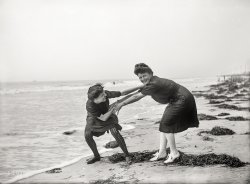
- GM on the Beach: 1964
- Another look at the fading Atlantic City from my grandfather's family trip in 1964. View full size.
Vaughn ... picture to some of the turn of the century photos of Atlantic City. One person on the beach? At least Al Martino still had a gig ... Posted by adamgilson - 05/16/2015 - 1:38pm -
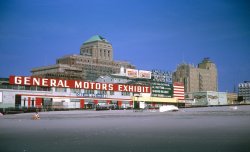
- A Little Fun: 1901
- ... Circa 1901, back at the Jersey Shore. "Riding donkeys, Atlantic City." Note the roller coaster in the distance on Young's Pier. Detroit ... Posted by Dave - 08/14/2012 - 12:54pm -
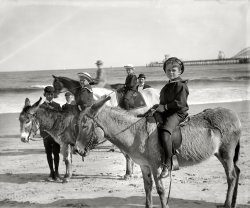
- By the Sea: 1908
- ... circa 1908. "Marlborough-Blenheim hotel and Boardwalk, Atlantic City." 8x10 inch dry plate glass negative. View full size.
Luxe ... Posted by Dave - 04/29/2016 - 2:09pm -
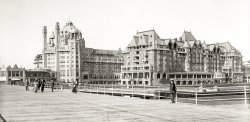
- Hotel Poinsettia: 1915
- Circa 1915. "The beach and Boardwalk, Atlantic City." Back to the beach with another high-resolution panorama, this one made ... Posted by Dave - 07/17/2012 - 10:35pm -
![Hotel Poinsettia: 1915 Circa 1915. "The beach and Boardwalk, Atlantic City." Back to the beach with another high-resolution panorama, this one made from two 8x10 inch glass negatives. Detroit Publishing Company. View full size.
Beach AttireSkimmers for the gents and parasols for the ladies was all the fashion. But I think of that iconic photo of Richard Nixon walking on the SoCal beach in his suit when I see photos like this one. Nowadays I doubt you'd see long pants at the beach let alone a full suit or fancy dress.
TraditionYa gotta build a sand castle! It's almost a rule! Interesting to note the evolution of swimwear when this shot is compared to earlier photos of beaches, either here or at Coney Island.
These panorama are such a treat, especially when the radio just happens to be playing the Nat King Cole song, "Those Lazy, Hazy Days of Summer!" Perfect Timing.
ContrastsThis photograph is a wonderful example of the difference between the crowds in their finery promenading on the Boardwalk, and the laid back people cavorting on the beach. So many candid views - the newspaper boy seems out of place on the beach.
I'll stick to the old daysThis current shot of the AC Boardwalk so totally lacks the fun and energy of the 1915 picture. So much for "progress." Now to find a way to walk into that old picture. How did they do it in "Somewhere in Time"?
Teddy Roosevelt goes to the beachThat's got to be him sitting on the sand facing the camera. Maybe he was planning to see Eddie Foy at the Criterion.
All kidding aside, another fantastic beach montage. I still don't understand how all those ladies & gents promenading down the boardwalk clothed in layers from hat to spats aren't keeling over from heat prostration in 90-degree heat and sun. How did they do it?
[It might not be 90, or anything close. - Dave]
Looking For SomeoneThere is ia young woman standing toward the left of the photo. She is shielding her eyes from the sun and is looking out toward the beach...or the water. Even though I can't get a closer look at her, I can tell she is pretty.
This is what drives me nuts about Shorpy, Dave. You don't have a Time Machine so I can go and meet her. Maybe she was looking for me.
Sand in your clothes?I find it interesting that in all the theses beach scenes, unless they rented a chair or cabana, people just plopped down right on the sand in either their bathing suits or street clothes. No towels or blankets.
Guess they didn't mind taking a little of the beach home with them.
Clysmic Table waterBottled water has been around for at least 100 years.
The illuminated sign on the far right must have been impressive after dark.
AlasSuch a simple concept: the beach towel. What entrepreneur will step forward and offer a 6 by 3 piece of terrycloth to spread across the hot sands? Where's my time machine?
Hotel Dunlop
I've found nothing on Hotel Poinsettia, but I have researched a bit about Hotel Dunlop, which stood at Mount Vernon and Pacific Avenues.
Sometime between when this picture was taken and 1916 the name of the hotel was changed to Hotel Overbrook and burned on February 4, 1916, killing six.
[That's not the same building as the one in our photo. - Dave]
People Being People In Their TimeI look at those people having fun in their time. When they look into the camera they're looking into the future. We're looking into the past.
(Panoramas, Atlantic City, DPC, Swimming)](https://www.shorpy.com/files/images/SHORPY_Atlantic_City_Panorama_2_11.thumbnail.jpg)
- National City Bank: 1912
- New York circa 1912. "National City Bank, Wall Street at William Street." Also the Atlantic Building, and a sliver of U.S. Trust. Detroit Publishing Company glass ... Beaux-Arts extravaganza facing Bowling Green, the National City Bank bought the building and hired McKim, Mead and White to expand it ... Posted by Dave - 04/18/2022 - 4:13pm -
![National City Bank: 1912 New York circa 1912. "National City Bank, Wall Street at William Street." Also the Atlantic Building, and a sliver of U.S. Trust. Detroit Publishing Company glass negative. View full size.
Piggy-back... if not "piggy bank". They don't build 'em like this anymore (actually, they didn't even build 'em like this then: the upper floors were a later addition.)
From U.S. Custom House > Bank HQ > Luxury Hotel > Condos: all while its cousins in other cities were consigned to the landfill in their youth ... some buildings have all the luck !!
110 years laterIt's a scarier world on Wall Street; here and look to your right.
The Merchants' ExchangeThis building has an extraordinary architectural history. It was built in 1836-1841 as the Merchants' Exchange, designed by architect Isaiah Rogers from Boston. The original building consisted of only the lower three stories, with the Ionic colonnade, and a big dome in the center of the block. As such, it was clearly modeled after Karl Friedrich Schinkel's Altes Museum in Berlin, built 1822-1828. From 1862 on it served as the US Custom House, which had been housed in what is now called the Federal Hall National Memorial (aka the Subtreasury) at Wall Street and Nassau Street. When the Custom House moved out to occupy Cass Gilbert's Beaux-Arts extravaganza facing Bowling Green, the National City Bank bought the building and hired McKim, Mead and White to expand it (1907-1910). Charles F. McKim decided to double the building in height by adding four more stories with a Corinthian colonnade on top of the original Ionic structure, while creating an entirely new interior with an impressive domed banking hall at the center. He integrated his addition so well that you would hardly suspect it was ever added in the first place!
One pieceThe Bank building with its formidable pillars began life as the Merchants Exchange building. Those pillars came down the Hudson River -- and are one piece of stone -- no joints.
[There are joints in the upper columns. - Dave]
Melville's neighborhoodHerman Melville worked as a customs inspector in New York from 1866 to 1885. His work was around the wharves, and inspectors had to rent their own work space nearby. But he would have been in and out of this Custom House over two decades.
Melville was paid four dollars a day for a six-day work week. He never received a promotion or a raise in pay.
(The Gallery, DPC, NYC)](https://www.shorpy.com/files/images/SHORPY-4a25611a1.thumbnail.jpg)
- The Water's Fine: 1914
- Atlantic City circa 1914. "The Boardwalk and hotels -- Chalfonte and Haddon Hall." 8x10 ... less traffic and was very private. We enjoyed all that Atlantic City had to offer in a very quiet way.
(The Gallery, Atlantic ... Posted by Dave - 04/02/2018 - 5:05pm -
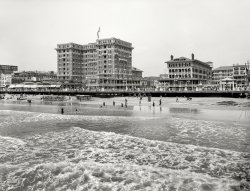
- A Place in the Sun: 1910
- The Jersey Shore circa 1910. "Bathers at Atlantic City." Many of them gamely striking a pose for the camera as they peer into the ... Posted by Dave - 11/09/2012 - 1:36pm -
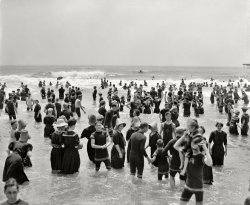
- Beach Scene: 1908
- The Jersey Shore circa 1908. "The bathing hour, Atlantic City." 8x10 inch dry plate glass negative, Detroit Publishing Company. View ... Posted by Dave - 08/26/2017 - 5:27pm -
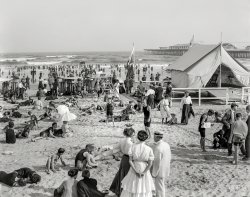
- The Dennis: 1901
- "The Dennis, Atlantic City, 1901." Decades before The Donald came to town. 8x10 inch dry plate glass ... into the Bally's complex. -tterrace]
(The Gallery, Atlantic City, DPC, Swimming) ... Posted by Dave - 06/08/2016 - 7:21pm -
![The Dennis: 1901 "The Dennis, Atlantic City, 1901." Decades before The Donald came to town. 8x10 inch dry plate glass negative, Detroit Publishing Company. View full size.
Lady on leftEdith, I swear if it get any hotter I'm going swimming clothes and all!
Second Boy from the right"Hey Elmer, check out the ankles on that chick"
No towelsMust have been an extra sandy experience, back then.
The Dennis"You'll love our pine-scented beaches.'
Not wheelchair compliantIt appears the hotel is not ADA compliant. There is a wheelchair at the bottom of the stairs on the left. Looks like the user is hobbling up the stairs to her room. I hope they didn't put her on the top floor.
No light colored parasols here, just dark rain bumbershoots to hide under.
I really enjoy looking at these pictures on my tablet. The spreading of the fingers zoom feature allows one to check the fine detail. Keep up the good work!
[The vehicle at the foot of the stairs is a "rolling chair," used to convey guests along the Boardwalk. - Dave]
Trees on the beachWhy are all the trees stacked up on the beach in front of the fence? Some kind of erosion control?
Strange effect The kid in front of the two ladies looks like he fell out of a Winslow Homer painting and landed on the beach.
Trees on the beach, a Jersey Shore traditionAlthough those don't look like Scotch Pines and Doug Firs, they may be there for the same reason hundreds of New Jersey towns, at least throughout my youth, used to collect used Christmas trees at curbside and send them on a seaside excursion. Yes, it was for erosion control, they claimed... possibly to keep the sands from swirling and shifting during the rough winter-spring transition.
Earlier generationWhile the Dennis Hotel is still used by Bally, this picture is of an earlier incarnation of the hotel:
"The latest version of the Dennis, pre-casinos, was constructed between 1919 and 1925, Kutschera said. It was built in the French regency style, with a distinctive mansard roof."
[Other Shorpy photos show mansard roofs present as early as 1905 and 1908. -tterrace]
Where?Anyone have any idea of where in AC this hotel was. I will be going to AC in 3 weeks and would like to see what's there now.
[It's still there, now incorporated into the Bally's complex. -tterrace]
(The Gallery, Atlantic City, DPC, Swimming)](https://www.shorpy.com/files/images/SHORPY-4a09096a1.thumbnail.jpg)























